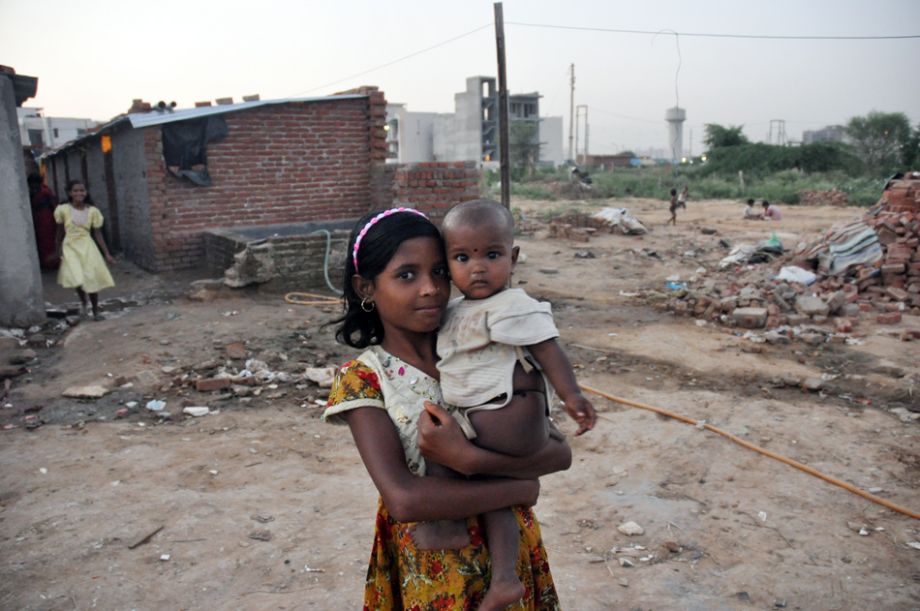The speed at which Gurgaon, a sprawling Indian city just outside New Delhi, has grown is astonishing: Just two decades ago, it was a rural backwater; today, it is metropolis of more than 1.5 million and counting. With that growth has come not only unsustainable sprawl, but also stark inequality and political corruption. Writing in Forefront this week, Sarah Goodyear takes a look at a new generation of voices in Gurgaon calling for reform.
The side of the road in Gurgaon is a bad place to be if you’re on foot, because there isn’t much of it there. The sidewalks, if they exist at all, tend to be narrow, busted up and blocked by overgrown foliage or random piles of garbage. Pedestrian signals are nonexistent. Everywhere is traffic, which roars and coughs along without pause, surging and blaring and jamming. It churns up a thin mist of dust that coats everything.
Yet here I am, standing like a fool by the side of the road, head scrambled by the noise and an omnipresent sun, on my mobile with a citizenship activist named Vinita Singh. She is somewhere in the river of cars, auto rickshaws, motorbikes, trucks and buses.
She tries to guide me. “Keep going to your right and you should see me,” she says. I look to the right. I see only a wall of trees. She rings off.
Just then, a group of feral pigs runs past me from behind, snorting and tossing their heads. I look ahead and see that a motorbike rider, tired of waiting for the traffic to move, has jumped up onto the sidewalk. He is headed straight for me, followed by another, and another, and another. I am clinging to the narrow peninsula of pavement between the bikes and the pigs when my mobile rings again. “I can see you,” Vinita says. “You just have to cross the road to get to me.”
She is smiling and waving, standing next to her neat little white car. Between us swirl four lanes of two-way traffic. Or five lanes, or six lanes, or none, depending on the way the ever-shifting chaos resolves itself at any given moment.
Once I make it to the other side and jump into her car, everything is, literally and figuratively, cool. The inside of the vehicle is air-conditioned and spotless. I am sweaty and shaken, but Vinita herself has not a hair out of place. Her white kurta is crisp and immaculate.
As she puts the car into gear, I lean back and relax, looking through the window at the people walking along the roadside. I am not one of them anymore.
This is the way it is in Gurgaon, India, a suburb of New Delhi and one of the fastest-growing cities in one of the most rapidly urbanizing countries on the planet. It’s growth that has been financed and supervised almost entirely by the private sector. A quarter-century ago, Gurgaon was a village backwater. Now there are 1.5 million people living there, and more moving in every day. The city’s median income is the third-highest in India, and it produces 70 percent of the revenue for the state of Haryana, where it is located.
The roads leading to Gurgaon may not be easy to navigate, but global capital has managed to find the way. In the beginning, Suzuki’s Maruti car plant was the marquee employer here (the brand controls 46 percent of the high-octane Indian car market). Now, 400 of the Fortune 500 are said to have offices in Gurgaon. You’ll find outposts of Honeywell, Konica, Pepsi, Deloitte, Panasonic and pretty much any other brand name you would encounter in the flashing lights of any global city.
Visiting executives can get off the plane at the sleek new Terminal 4 of New Delhi’s Indira Gandhi International Airport, get picked up by a driver and be whisked directly toward Gurgaon on a modern expressway. In a matter of half an hour or so (that is, if there isn’t a hellacious traffic jam, which there often is) they can be checking in to a ritzy high-rise hotel, as well appointed as any in the global business sphere.
If they were to open the windows of those chauffeured cars or pricey rooms, they could smell the cooking fires burning in the slums that fill in the spaces between the skyscrapers, where hotel workers live with their families.
Indeed, Gurgaon is all about inside and outside. On the inside — of the cars and SUVs, of the scores of gated communities and office parks, of the high-end malls and five-star hotels and hospitals that cater to medical tourists from abroad — you will find the prosperous “new India.” Everything is peaceful. Everything works. The power might go out for a few seconds or even a minute, but it always comes back on, because there are backup generators that provide electricity at a premium rate. Turn the tap, and water comes out, trucked in from somewhere else. The toilets flush, and the sewage is taken care of, by somebody. Entrepreneurs plot international business moves over high-speed WiFi connections. The garbage is hauled away, even if you don’t know where it goes. The flowers blossom.
On the outside of the windows and walls, the poor and working class sweat it out, facing constant power and water shortages. Outside, people scramble for inadequate and even dangerous transportation, and watch as rising food costs eat away their small wages. Outside, the feral pigs roam free. Gurgaon has come to embody unprecedented upward mobility and economic opportunity, but also gaping disparity and dysfunction.
And yet the city’s Wild West atmosphere, while frustrating and sometimes destructive, makes this a place where just about anything seems possible — even a better, cleaner, safer Gurgaon. The same entrepreneurial energy and openness that has made Gurgaon an international destination is beginning to manifest in the civic realm. Increasingly, ordinary citizens are stepping in to mop up the mess left behind by unchecked development, corruption and lack of planning. People like Vinita Singh — who on the day I met her was on her way to help a group of poor women in an unauthorized settlement to secure food aid they’re entitled to — are no longer willing to be bystanders to a corrupt, ineffectual public realm.
Even in the political sphere, which in India is notoriously marked by apathy among the educated middle class, that sense of possibility is inspiring a new generation to wade in and get to work. Nisha Singh is a good example. Singh (no relation to Vinita) is a member of the new city council that was voted in for the first time just last year, but she’s not a career politician and enjoys bucking the stereotype. Her Twitter bio reads, “Contested Municipal Elections. Followed every rule and still won! Now trying to make a difference. Hope to inspire others to take up ethical politics in India.”
She deals every day with constituents who come to her for solutions to the city’s cascade of problems, but hasn’t lost sight of the tremendous energy Gurgaon has to offer. “People love the freedom, diversity and newness of Gurgaon,” she says. “Right now, it’s a love-hate relationship. Fifty percent love it, 50 percent hate it. Someday I hope the balance will tip.”
Tipping that balance is critical not only for Gurgaon’s future but for the future of globally interconnected cities everywhere: Can a place that has become the unwitting model for untrammeled, privately led growth model a new breed of city built by the private sector but shaped by public interests?
To read more, subscribe to Forefront. Already a subscriber? Click here to continue reading.
















